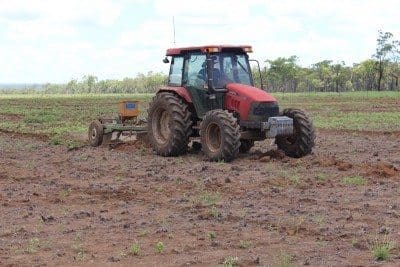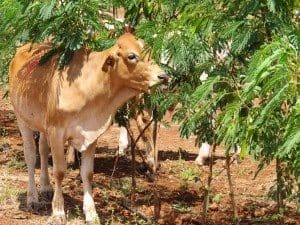A grazing trial underway in northern Queensland will compare the weight gain performance of cattle grazing on the soon-to-be-released psyllid resistant Leucaena variety Redlands and on the commonly used Wondergraze variety.
Redlands is a hybrid variety of Leucaena developed to resist psyllids, tiny sap-sucking insects which attack the tropical forage tree and which have prevented its establishment in the more humid regions of northern Australia.
Redlands was developed by University of Queensland researchers with Meat & Livestock Australia funding.
It is expected to open up a further 1.5 million hectares of grazing land in northern Australia to potential Leucaena establishment.
Leucaena is already established on an estimated 200,000 hectares of grazing country, predominantly in Central Queensland. MLA estimates that the nutritional value provided by Leucaena has added around 50,000 tonnes of liveweight gain per year worth an extra $100 million a year to Queensland’s annual beef production.
MLA last year awarded Redlands seed growing contracts to two landholders in Central Queensland, Carnarvon Pastoral Company and Leucseeds. Both seed growing partnerships are expected to have commercial volumes of seed available for producers to purchase by 2017.
Lab tests have shown that Redlands has similar protein levels and digestibility to existing commercial lines, such as Cunningham and Wondergraze.
The new grazing trial, recently funded by MLA as a Producer Research Site (PRS), is being run by the Queensland Department of Agriculture and Fisheries Far North Beef team on Cameron Burtenshaw’s Mount Garnet-district property St Ronan’s.
The trial will test comparative weight gain performance of Redlands against the benchmark Leucaena variety Wondergraze.
The Leucaena varieties have recently been planted in a 60 hectare site which is divided into eight grazing plots.
MLA General Manager of On Farm Innovation & Adoption, Dr Matt McDonagh, said the project should provide evidence that cattle on the new variety perform over long periods of feeding.
Dr McDonagh said the trial would demonstrate the comparative weight gains of Redlands next to Wondergraze, one of the benchmark Leucaena varieties commonly used in industry.
“More than that, Redlands will have increased psyllid resistance. We will be able to show that the productivity of the plant will be better over the whole grazing year. Redlands is not going to suffer the same psyllid-attack and loss of productivity due to psyllids,” he said.
“We are hoping to demonstrate to producers that we actually get an increased production and productivity outcome from Redlands Leucaena.”
The trial has been funded for two years, and the results should coincide with the release of commercial volumes of seed from the two seed orchards in Central Queensland. Both now have germinated seed in the ground and are anticipating a first seed harvest later this year.
Another trial is currently being conducted on Mount Garnet district property Whitewater to test the palatability of the Redlands variety relative to other commercial varieties.
Dr McDonagh said the new psyllid resistant variety of Leucaena offered significant potential to improve cattle industry productivity in northern Australia.
“The information that we have had in the past on Leucaena suggests that in that the far northern Queensland environment, around 240kg of liveweight gain per year should be achievable.
“It gives producers potentially large gain there.
“There is a large cost of establishment that goes with it. That is why is we also need to de-risk establishment for producers so they can make the most out of their investment with putting something like Leucaena in the ground.”
Planting update

Redlands being planted by Greg Brown. More pictures of the establishment phased can be viewed at bottom of article.
Craig Lemin from the Queensland Department of Agriculture and Fisheries (QDAF) is currently overseeing the establishment of Leucaena on the 60 hectare trial site on St Ronan’s.
The site has been divided into eight paddocks of about eight hectares each, four of which have been planted to the Redlands variety and four to the Wondergraze variety.
Mr Lemin said the trial will be fully replicated to ensure that any differences that occur between the cattle grazing on both varieties can be attributed as much as possible to the different varieties themselves.
The first challenge is to get the Leucaena treatments successfully established and up and growing.
Mr Lemin said all eight treatment paddocks have now been planted (four to Wondergraze, and four to Redlands), but noted that the recent heavy rain had made conditions very challenging.
The Leucaena has been planted to 10m row spacings on relatively flat country that comprises a mix of grass land and former cropping land previously sown to forage and grain crops.
The area was initially cleared of fallen timber and regrowth by the property owner and then ripped by dozers in mid December.
It then received a massive 275mm rain deluge between Christmas and New Year.
When the ground was dry enough to work sulfur was applied at a rate of 55 kilograms per hectare and Gran-Am fertiliser at 100kg per hectare.
The area also received an aerial spray with glyphosate, but spectacular grass growth particularly on the previously cropped area still ensued, meaning the area had to be resprayed with a tractor and boom in early February.
Mr Lemin said three treatment areas were planted to Leucaena in mid-February – two to Wondergraze and one to Redlands.
A suite of different grass-seed varieties (including Sabi grass, Tolgar Rhodes, Gatton Panic, G2 Panic) was also broadcast between the rows using a fertiliser spreader and then harrowed in.
Dry conditions delayed further planting until February 28 when another 40mm was received.
On March 2-3 the remaining five treatment areas were planted, and two of the earlier planted paddocks were also replanted at the same time, because the earlier plantings had not emerged by that time.
Immediately after planting a pre-emergent treatment of Spinnaker herbicide was also applied.
Another massive rain event then occurred a few days later on March 5, when the site was hit by a heavy 40mm storm and then another 60mm downpour the next day. It is still too early to tell what impact that rain event has had on the plantings.
Provided the establishment phase succeeds, Mr Lemin said it is envisaged that the first cattle for the grazing trial would enter the site in about 12 months time.
That would involve dividing a uniform group of Brahman type steers into eight even cohorts of about eight head each, with each cohort given one eight hectare treatment area to graze, ideally for a period of eight to nine months.
Mr Lemin said he believed the trial would show that the psyllid resistant variety will be more productive in the psyllid-prone environments of the north.
“Given the evidence of how the other varieties get defoliated (by psyllids), and how quickly it can happen and effect the productivity of the plant, if you can avoid that you are way out ahead,” he said.
Provided the Leucaena is successfully established this season and has a full year to grow, Mr Lemin said the results of the first year of grazing trials should be known around the same time that the first commercial volumes of seed are being released.
- Click on thumbnails below to view more images of the Leucaena planting process.




HAVE YOUR SAY